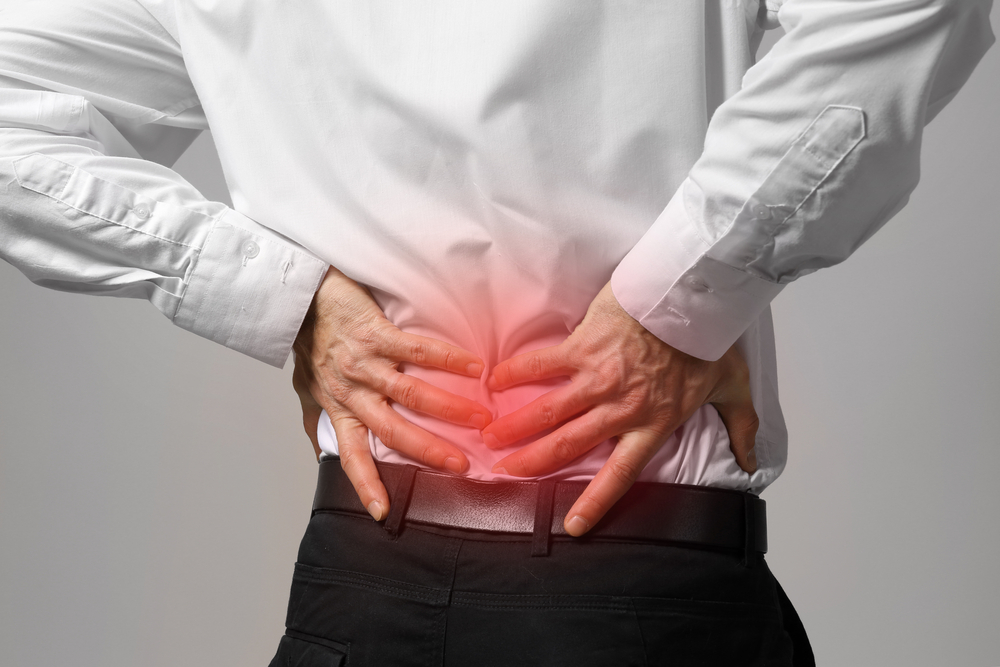Lower back pain is an issue affecting millions of people in the UK, causing discomfort and impacting daily life. Whether it’s a dull ache or a sharp, stabbing sensation, lower back pain can significantly reduce mobility and quality of life if left untreated.
Our experts have put together your complete guide to understanding lower back pain: the causes, symptoms, and treatments, providing valuable insights and actionable tips for those suffering.

Causes of Lower Back Pain
Muscle Strain
Overexertion or sudden movements can strain the muscles and ligaments in the lower back, leading to pain and discomfort.
Herniated Discs
The soft cushions between vertebrae can bulge or rupture, pressing on nearby nerves and causing pain.
Degenerative Conditions
Conditions such as osteoarthritis or degenerative disc disease can lead to the breakdown of spinal discs and joints, resulting in pain.
Spinal Stenosis
This condition involves the narrowing of the spinal canal, putting pressure on the spinal cord and nerves, often leading to lower back pain.
Skeletal Irregularities
Conditions like scoliosis, where the spine curves abnormally, can contribute to lower back pain.
Symptoms of Lower Back Pain
Lower back pain can manifest in various ways, including:
- Dull, aching pain: Some people experience a persistent, dull ache in the lower back region.
- Sharp, shooting pain: Many may feel sharp, shooting pains that radiate down the legs, indicating nerve involvement.
- Stiffness: Lower back pain often accompanies stiffness, making it challenging to move or bend.
- Muscle spasms: In some cases, muscle spasms may occur, further exacerbating the pain and discomfort.
- Limited mobility: Severe lower back pain can significantly restrict mobility, affecting daily activities.
- Changes in sensation, muscle strength : When nerve irritation/compression is present, changes in muscle strength and sensation in the lower extremity can occur. If this is present in both legs along with changes in bladder and bowel habits, this requires urgent medical attention.
Treatment for Lower Back Pain
Treatment for lower back pain typically involves a combination of therapies tailored to the individual’s specific condition.
Manual Therapy
Manual therapy, such as manipulation and mobilisation of the spine, involves passively moving joints to help alleviate stiffness and pain and improve mobility.
Massage
Skilled therapy is directed at muscles, fascia, tendons and ligaments which helps alleviate tight and aching muscles, improve muscle imbalances and improve performance.
Dry Needling
Dry needling or medical acupuncture is a treatment that is used for pain relief and movement issues associated with myofascial trigger points. It maybe beneficial in reducing pain and muscular tension.
Progressive Exercises: Pilates and Functional Exercises
Targeted exercises and stretches can help strengthen the muscles supporting the lower back, improving flexibility and reducing pain.
Pain Medication
Over-the-counter or prescription pain medications can provide temporary relief from lower back pain.
Hot and Cold Therapy
Applying heat packs or ice packs to the affected area can help alleviate pain and reduce inflammation.
Injections
In some cases, corticosteroid injections may be administered to reduce inflammation and alleviate pain.
Surgery
In severe cases where conservative treatments fail to provide relief, surgery may be considered to address underlying structural issues.
How can I prevent Lower Back Pain?
While not all instances of lower back pain can be prevented, adopting certain habits and lifestyle changes can reduce the risk.
- Maintaining a healthy weight: Excess weight puts strain on the lower back, so maintaining a healthy weight can alleviate pressure on the spine.
- Regular exercise: Engaging in regular physical activity can strengthen the muscles supporting the lower back and improve flexibility.
- Correct lifting techniques: When lifting heavy objects, bend the knees and keep the back straight to avoid strain on the lower back.
- Ergonomic workspace: Ensure your workspace is set up ergonomically, with proper chair support and monitor height to maintain good posture.
- Quit smoking: Smoking can impair blood flow to the spine and contribute to disc degeneration, so quitting smoking can benefit overall spinal health.
Book an appointment with Bodymotion today
Bodymotion’s London Chiropractors provide chiropractic treatment for those suffering from back pain.
At Bodymotion, this includes a package of care including safe, gentle, specific spinal manipulation to free stiff joints in the spine or other areas of the body. We may also offer soft tissue work, dry needling and rehabilitation exercises.
The first consultation with your chiropractor takes approximately 45-55 minutes. It is during this consultation that information is obtained so that a diagnosis can be made.
Our team of chiropractors and massage therapists are on hand to answer any questions you may have, so get in touch today via enquiries@body-motion.co.uk or on +44 (0)20 7374 2272.
